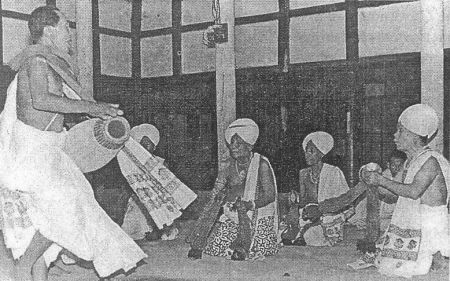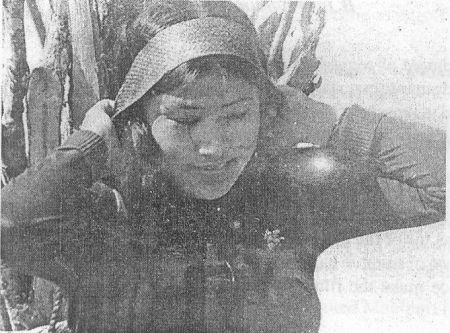SHORT AND DOCUMENTARY FILMS IN MANIPUR
Part 2 - 1990-1997
Salam Rajesh *
In 1990
The film INDIGENOUS GAMES OF MANIPUR, directed by Aribam Syam Sharma and produced for Doordarshan, highlights the several indigenous games played in Manipur, such as the Cheibi, Mukna, Yubi Lakpi, Mukna Kangjei, Hiyang, Kang and Sagol Kangjei, from time immemorial. The film is in 16mm colour with commentary in English. Duration of the film is 72 minutes.
The film bagged the National Award for Best Exploration/Adventure Film in the 38th National Film Festival in 1991.
In 1991
a) The film MEITEI PUNG, directed by Aribam Syam Sharma and produced for Doordarshan, dwells into the mysticism and the aestheticism of the indigenous percussion music of the Meiteis in Manipur. The film brings out the beauty of the Meitei artistes in lively performance. The Meitei Pung, the barrel-shaped Manipuri drum, is focussed as an essential part of the Manipuri life & culture.
The film is in 35mm colour. Duration of the film is 30 min utes, with commentary in En glish. The film bagged the Spe cial Jury Award in the 39th National Film Festival held in 1992.

A scene from "Meitei Pung"
b) The film GORKHA OF MANIPUR, directed by Sanakhya Ibotombi and produced by B.R.Chhetri for the Avant Garde, Imphal takes up as its subject the Gorkhas in service and in daily life as observed in the state. The film is in 16mm colour. Duration of film is 20 minutes.
c) The film YAOSHANG, directed by Sanakhya Ibotombi and produced by R.K.Binoy for the Avant Garde, records the event of the annual festival Yaoshang in Manipur. The film is in 16mm colour. Commentary is in both English and Manipuri (Meiteilori).
In 1992
The film Lai Haraoba, directed by Aribam Syam Sharma and produced for the Indira Gandhi National Centre for the Arts, New Delhi goes in length to dwell into the different aspects of the Lai Haraoba performances, particularly the associated rituals and the dance performances. Shot in 16mm colour, with a duration of 60 minutes.
In 1993
The film MOIRANG PARVA, a joint production of the Directorate of Art & Culture, Government of Manipur and the East Zone Cultural Centre, Calcutta deals with the aesthetics of the Moirang Parva, the traditional folk oral recital that narrates stories from the lives of the legendary characters Khamba and Thoibi of Moirang. The film is in 35mm colour. Duration of film is 28 minutes.
In 1994
a) The film ORCHIDS OF MANIPUR, directed by Aribam Syam Sharma and produced for the Forest Department, Government of Manipur,
draws as its theme a picture of the beautiful, lovely orchid flowers of Manipur, in their assorted varieties and environment.
The connected lores are also emphasised. The film is in 35mm colour, with commentary in Manipuri (Meiteilon). The duration of the film
is 26 minutes.
Of the recognitions it had achieved, the film bagged the National Award for Best Environment/Conservation/Preservation Film in 1995.
It was screened in the Indian Panorama section of IFFI in 1994. The film participated in the International Wildlife Film Festival
at Morocco in 1996. The film had also been approved by the External Affairs Ministry, Government of India for purchase by foreign exhibitors.
c) The film PENA, a film by Makhon Mani Mongshaba, seeks to explore the philosophy and the aesthetics of the traditional Pena music that has encaptured people of all walks of life and communities by its mystic, luring renderings. The film also highlights Pena performance in ritualistic performances. With a duration of 18 minutes, the film is in 35mm colour.
In 1995
The film YELHOUJAGOI (The Dances of Lai Haraoba), directed by Aribam Syam Sharma and produced for the Indira Gandhi National Centre for the Arts (IGNCA), New Delhi, is based on the creation myth narrated and enacted in the Lai Haraoba (festivities of the gods). Having a duration of 30 minutes, the film is in 35mm colour. There is no commentary in the film, which by itself is a peculiar character of the film. A brief introduction is given in the opening of the film.
The film had the rare honour to open the film festival of the Indian Panorama section of the International Film Festival of India in January 1996 at the Siri Fort Auditorium, New Delhi. The film bagged the National Award for the Best Anthropological/Ethnographical
Film in 1996.
In 1997
The film LAA (The Banana Leaf), a film by Thouyangba and Thoungamba for P.K.Films Manipur, has as its subject the different uses of the banana leaf in the daily and the customary life of the Meiteis in the Manipur valley, with the associated beliefs connected to the use of the banana leaf on particular occasions.
Shot in 35mm colour, the duration of film is 26 minutes. The film has commentary in English. The script is written by M.K.Binodini Devi.
The Short Features
In 1984
a) The film PAOKHUM AMA, directed by Aribam Syam Sharma and produced for Films Division of India, takes up theme on the problems of unemployment and the frustration of the youths in failing to secure monetary and social security, while on another plane it dwells on the inter-relationship of two major communities in Manipur.

A scene from "Paokhum Ama"
The film dwellscon the unsaid romance of a Meitei youth, who reaches a village in Ukhrul to seek his fortune, and a young Tangkhul girl of that village. The finale comes when the girl gets married to one of her own community in another village, and the youngman
returns to the village from a visit to home in Imphal just in time to bid her a silent farewell.
The film while centering on the contemporary subject of unemployment of educated youths, also attempts, in its flow, to establish a friendly relationship of the hills and the plains, away from the milieu of human polity and social stigmas.
The film is shot in 16mm colour. Duration of the film is 70 minutes. The film went on to participate in the Tyneside International Film Festival, United Kingdoms in 1984.
b) The film THABA, directed by Kongbrailatpam Ibohal Sharma and pro duced by Kh.Pramodini Devi for the Department of Women & Child Programme (now renamed Department of Social Welfare), Government of Manipur, is shot in 16mm colour. The film is sponsored by the United Nations International Children's Emergency Fund, UNICEF. The film dwells on the social issues of women and children in the region.
In 1986
The film TREE OF LIFE is directed by L.K.Shimray and produced by K.Nongban Singh for the Film Production Centre, Kwatheithel. The copyright of the film is held by L.Chitra Devi, proprietor of the FPC. The film is shot in 35mm colour. Having duration of 10 minutes, the medium of film is in Manipuri (Meiteilon).
The film was first screened officially at the Gandhi Memorial hall in Imphal on February 23 in 1986. During that year, the film was exhibited in all the districts of Manipur for the Women's Development Programme, organised by the Manipur Rural Institute under the sponsorship of the OXFAM (India).
The main casts in the film are R.K.Shushila, Prafullo, Gambhini, Manisana and others. The film revolves around the sufferings of a neglected mother of five children, who struggles to survive in life.
